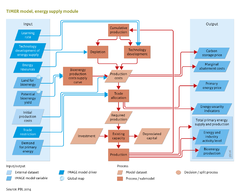Energy supply: Difference between revisions
Jump to navigation
Jump to search
m (Text replace - "Roads from Rio+20 (2012)" to "Roads from Rio+20 (2012) project") |
No edit summary |
||
| Line 3: | Line 3: | ||
|IMAGEComponent=Scenario drivers; Land cover and use; Crop and grass; Emissions; Climate policy; Atmospheric composition and climate; Energy demand; Energy conversion; Energy supply and demand; | |IMAGEComponent=Scenario drivers; Land cover and use; Crop and grass; Emissions; Climate policy; Atmospheric composition and climate; Energy demand; Energy conversion; Energy supply and demand; | ||
|KeyReference=De Vries et al., 2007; Van Vuuren et al., 2008; Van Vuuren et al., 2009; | |KeyReference=De Vries et al., 2007; Van Vuuren et al., 2008; Van Vuuren et al., 2009; | ||
|InputVar=Technology development; Energy resources; Trade restrictions; Demand for primary energy; Land for bioenergy | |InputVar=Technology development; Energy resources; Trade restrictions; Demand for primary energy; Land for bioenergy; Potential bioenergy yield - grid; | ||
|OutputVar=Primary energy price; Carbon storage cost; Bioenergy crops production; Energy security indicators; Total primary energy supply; Marginal abatement cost; | |OutputVar=Primary energy price; Carbon storage cost; Bioenergy crops production; Energy security indicators; Total primary energy supply; Marginal abatement cost; | ||
|Parameter=Initial production costs of energy supply technologies | |Parameter=Initial production costs of energy supply technologies | ||
Revision as of 13:36, 30 January 2014
| Component is implemented in: |
|
| Related IMAGE components |
| Projects/Applications |
| Key publications |
Key policy issues
- How can energy resources be exploited to meet future primary energy demand?
- How can energy supply and demand be balanced between world regions, and how will this effect security of supply?
- How rapidly can the transition to more sustainable energy supply be made?
